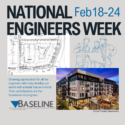by Aaron Demo, PLS
 Professional Land Surveyors are constantly helping clients understand what they need when they say “survey”. Surveys can range from Improvement Location Certificates (“ILCs”) to the infamous “ALTA Surveys”. Surveys are generally subject to state and local regulations, but can vary dramatically. The ALTA survey is unique because it is governed by detailed requirements. It should only vary based on specific, client-dictated requirements.
Professional Land Surveyors are constantly helping clients understand what they need when they say “survey”. Surveys can range from Improvement Location Certificates (“ILCs”) to the infamous “ALTA Surveys”. Surveys are generally subject to state and local regulations, but can vary dramatically. The ALTA survey is unique because it is governed by detailed requirements. It should only vary based on specific, client-dictated requirements.
The American Land Title Association/American Congress on Surveying and Mapping (“ALTA/ACSM” or just “ALTA”) surveys are considered to be the most complex, complete and accurate for land parcels. These surveys are compiled with a guarantee that they comply with requirements set forth by ALTA, ACSM and the National Society of Professional Surveyors.
ALTA surveys are typically necessary for issuing title or mortgage insurance on higher-value properties such as commercial, industrial or large residential parcels. These surveys must meet certain requirements to be ALTA surveys. They also have optional requirements that may or may not be appropriate for all sites. The ALTA requirements document (last updated in 2011) describes them.
Table A, located at the end of the ALTA requirements, is a set of optional items such as topography, utility locates of varying levels and parking space delineation. It also includes non-visible items that may encumber a property. Due to their complex and comprehensive nature, ALTAs are the most expensive land surveys. They can cost up to tens of thousands of dollars depending on a site’s size and complexity.
If land owners perform comprehensive ALTA surveys, they can usually recover their fees or provide added value to their transactions. For example, a seller of a parcel that will most likely be redeveloped can add value to the transfer by including utility information and topographic information to assist the future developer. It is always more cost effective to have these items surveyed up front within ALTA services than it is to hire another surveyor to fill in the gaps later.
What are factors to consider when ordering an ALTA?
- A title commitment is required. Provide it and all supporting documentation to the surveyor prior to beginning work.
- B-2 title exceptions (easements, covenants, conditions, restrictions, etc.) are underlying items that are not always visible on the ground, but need evaluation and may affect the property.
- Land mass and physical features will determine the minimum effort of surveying the ALTA’s standard requirements.
- In addition to standard requirements, Table A items may be required on the survey.
- Commercial sites and sites that are being redeveloped will require additional scope.
- ALTA’s are complex and have high standards. Provide ample time to complete them to ensure the best quality product.
An engineer, surveyor or land planner can provide guidance prior to ordering an ALTA survey. They can make sure all the parcel’s needs are satisfied in a timely and economic manner. Determining the scope of what is needed in the ALTA dictates the length of time and level of effort. Baseline Corporation staffs a key mix of professionals to assist with ALTAs and other land development projects.



